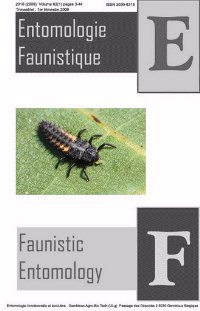- Home
- Volume 68 (2015)
- Un parasitoïde oophage pour contrôler Paysandisia archon (Burmeister, 1880) (Lepidoptera : Castniidae) : Le Trichogramme. Premier succès en laboratoire
View(s): 1574 (18 ULiège)
Download(s): 473 (13 ULiège)
Un parasitoïde oophage pour contrôler Paysandisia archon (Burmeister, 1880) (Lepidoptera : Castniidae) : Le Trichogramme. Premier succès en laboratoire

Résumé
Le papillon du palmier a été accidentellement introduit en Méditerranée en provenance d’Argentine, et il a su s’adapter au climat et aux espèces de palmiers présents. Depuis 2001, nous avons observé de nombreux dégâts naturels (trous de galeries, déformations et torsions des troncs, dessèchement des palmes), et des impacts économiques de l’ordre de 100 M€ (pour contrôler ce ravageur et le charançon des palmiers, Rhynchophorus ferrugineus (Olivier, 1790)). Les espèces de palmiers les plus attaquées en France, Italie et Espagne par ce papillon sont Chamaerops humilis (L., 1753), Trachycarpus fortunei ((Hook.) H.Wendl., 1863) et Phoenix canariensis (Hort. ex Chabaud, 1882).
Dans ce contexte, il est nécessaire de trouver une stratégie efficace et réalisable susceptible de réduire la population de ce ravageur, tout en respectant l’environnement et la santé humaine. Les méthodes alternatives actuellement disponibles sont chères et difficiles à mettre en place. Il est donc urgent de trouver et de développer un auxiliaire comme agent de contrôle biologique.
Dans le cadre du projet européen PalmProtect (2012-2014), notre objectif est de trouver des parasitoïdes oophages susceptibles de pondre dans les œufs du papillon.
Les trichogrammes sont connus pour le contrôle biologique de différentes cultures. De nombreuses souches de trichogrammes ont été testées dans cette étude sur des œufs du papillon selon une modalité. En condition contrôlée en laboratoire, certains trichogrammes ont réussi avec succès à parasiter les œufs du papillon. L’efficacité globale a été prise en compte au travers du nombre d’œufs avortés et parasités.
Ces résultats préliminaires étant marquants, il est nécessaire d’approfondir ces recherches. En effet, si l’étude du comportement du trichogramme sur palmiers donne de bons résultats, nous pourrions améliorer son efficacité et mettre en place une stratégie de lâcher. Le choix du parasitoïde oophage le plus efficace contre le papillon du palmier sera alors défini et la méthode de lutte développée.
Abstract
Palm Borer moth was accidentally introduced in Mediterranean area from Argentina and it has been adapted to the climate and the palm species in place. Since 2001, we have observed more damages on the nature (gallery holes, deformation and twisting of palm trunks, drying up of the palms…), and also economic impacts with more than 100 M€ (to control this pest and the Red Palm Weevil Rhynchophorus ferrugineus (Olivier, 1790)). The most PBM attacked palm species in France, Italy and Spain are Chamaerops humilis (L., 1753), Trachycarpus fortunei ((Hook.) H.Wendl., 1863) et Phoenix canariensis (Hort. ex Chabaud, 1882). In this context, it is required to find an efficient and practical strategy susceptible to reduce PBM population, respecting the environment and human health. Alternative methods currently available are expensive and the process is complex. Therefore it is required to find and develop beneficial insects as biological control agents. As part of the European project PalmProtect (2012-2014), the objective of this study is to find an egg parasitoid of PBM.
Trichogramma are known as biological control on different crops. Different strains of Trichogramma have been tested on the eggs of PBM according to one modality. Some of them have successfully parasitized P. argon eggs in laboratory. The global efficiency was also taken into account by the number of eggs aborted and parasited.
These preliminary results are very important which motive us to go on this research. Indeed, Trichogramma strains which have provided good results behavior studies will allow us to improve their efficiency and to set up release strategy. The choice of the most effective oophagous parasitoid against PBM could be improved.






